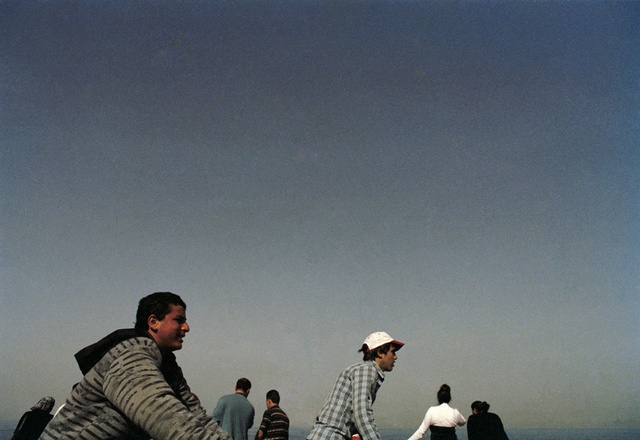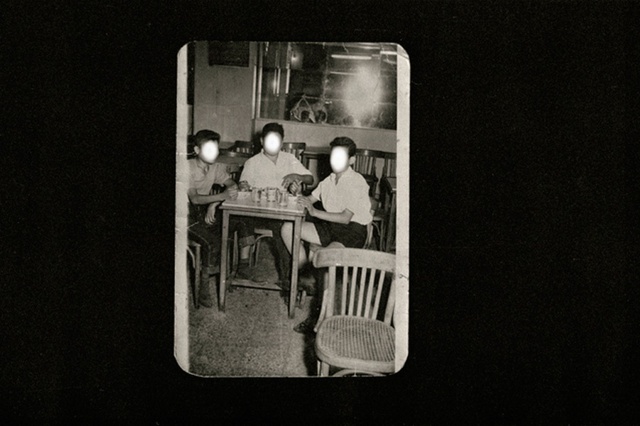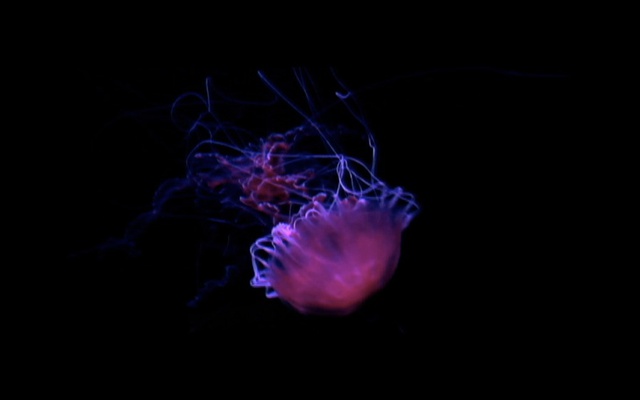Essays
Farther Than Language Can Reach
On the Work of Basma Alsharif
Writing about a work of art usually draws on an elapsed experience. This retroactive engagement raises the possibility that the life of an artwork continues its processes and transformations through language. Thus the act of writing itself becomes an act of searching for a trace of that absent work and a means of manifesting the work in front of the reader outside the gallery space. The writer does this without being able to actually reproduce or re-present the work. In this sense, this action – of taking language as one of the available means to make possible the participation of experiencing, reading or perceiving a work of art after the act of viewing has passed – necessarily involves a kind of failure, given that the medium of writing is not the medium of the artwork. For how could a writer transmit through words an action an artist produced through images? Moreover, the work of art itself is necessarily the evidence most missing in the written text, or the absence most oft evoked. After language peels away the major feature and the medium of the artwork, at best one may find a phantom presence. There is no need for a text that re-presents a work of art, as there is no need for a work of art that can be re-presented by a text.
Therefore, this text will avoid deeming the artwork as the subject, except insofar as it is necessary to bind together its scattered sections. Rather, it will look at the artworks produced by the artist who becomes the subject in the absent artwork's place. In this case, I will look at the work of Basma Alsharif, and I will begin by invoking the first impression that stayed with me after seeing Alsharif's 2012 exhibition, Farther Than The Eye Can See. The exhibition included several works, including Semi-Nomadic Debt-Ridden Bedouins (2006), Everywhere Was the Same (2007), We Began By Measuring Distance (2009), Turkish Delight (2010), The Story of Milk and Honey (2011), and the most recent, Farther Than The Eye Can See (2012). The impression that emerged from this grouping was the feeling of an underlying dilemma of complexity.
It seems to me that Basma Alsharif tries to grasp a kind of unknown world through her work – a world to which she is bound, but she doesn't know exactly how, why, or through what means. The characteristics of that world are more or less ambiguous. In any case, space or place, it is a world absent from the body of Alsharif's works, scattered between lines, images and sounds. Yet, the viewer's knowledge of that world can help him or her determine its characteristics, their manifestation and shape. For example, in Everywhere Was the Same and again in We Began By Measuring Distance, we meet a girl screaming on the seashore: 'Father…Father'. There is no further explanation for this voice; but it references the story of Huda Ghalya, whose whole family of seven was killed while strolling on the beach on a Friday evening in 2006 in Gaza by a missile shot from an Israeli naval ship. For one who knows that story, or for one who has heard the screams of that girl, the echo of her voice still vibrates in the ear after viewing Alsharif's homage to such a devastating loss. The aural medium in the film is like a burning fuse that can reawaken the terror of that day. This is also what gives the sea multiple meanings in Alsharif's works: a body that bears equal witness to massacre, playtime, nostalgia and siege. In portraying those conflicting connotations, images unfurl sometimes in a serene and coherent fashion, and sometimes explode and gush. In some works, the image changes from one to the next, in order to visually imitate the movement of our subconscious, such as in Turkish Delight. This technique can slow us down and make us see other depths or aspects in things, like following the measured motion of the camera on an embroidered garment while hearing the Fairuz song Sanarjiou (We Will Return, 1971). This slowness can render the representation either as a natural scene – a singular moment – or as the portrait of a whole nation.
Alsharif employs visual and aural materials that seem very familiar, almost banal, in a context like the Palestinian plight, such as the sound of emergency vehicles, the screaming of women mourning their martyred sons or the images of air strikes on Gaza during the last Israeli war. However, she presents them in a new way and in fragments, visual and aural, and juxtaposes them with other materials from totally contrasting fields, like natural sciences, plant manuals, or serene, ambiguous scenes of marine life. This achieves a new effect and perhaps a contrasting one in a way that could make the image sometimes betray itself, defy reality and trick the viewer – like the image of Gaza City and the sea with the song Qariat al-Fingan (The Fortuneteller) in the background; the image of white phosphate bombs that appear in Gaza's skies like beautiful fireworks; a scream without a body; or conversely, a woman screaming without sound.
One could see the artist's erasure of faces in her work The Story of Milk and Honey as an attempt to push towards the unknown, or to push the act of searching for meaning to the farthest edge. Jean Baudrillard says that 'revolutionary transformation in things today comes not from discursive juxtaposition but rather from the speed of their arrival at x-power'.[1] And it comes as no surprise that the video project The Story of Milk and Honey, which is itself a fundamental component of a larger installation of the same name, purports to being an autobiography of the process of producing a work of art. On top of that, it is possible to view that work in particular as representing a milestone in the artist's search for and discovery 'of the relationship between the unknown individual and political history and collective memory'.[2]
Alsharif's work reveals a profound sense of time (psychological). There is a sense of inherent memory in the raw elements of the art's media, and in the means by which those materials, or parts of them, were shaped into a work of art. Thus, her works involve a profound, composite confrontation. That confrontation can be seen between the elements of the works themselves, as preconceived by the artist, and their combinations into different moments and contexts, which proliferate according to a vague internal compass, between the artist's memory, the moment of the work's production, and in the possible interpretations the work invokes through new and old elements cast in a new context. Together, these confrontations crystallize in their final form in the moment of the exhibition itself.
One could describe this instance of confrontation as the true moment of artistic creation, where the artist tries to produce the work that she imagines at that moment in particular, by filling the artistic interface she chooses, using that particular material and by employing that particular method. And there remain further possibilities for subsequent works of art, and at times other uses of the same materials. For example, the sound fragment recalling the story of the girl Huda Ghalya, which repeats in more than one work; or the appearance of the sea in various scenes; different methods and contexts; or various aural materials, whether familiar songs, wordless music, narration or something else. This operation is bound by the time and place of the work's production, the options and limitations on the contents and form imposed by a particular context, and the accumulation in the artist's search for new materials, in turn bound by one question or concept articulated in the artist's text placed at the entrance of the exhibition.
There are many levels of encounter inherent in Alsharif's exhibitions. Chronologically, there is the encounter with the past and the present in a single moment. The past appears repeatedly in Alsharif's works, just as the present continually finds itself pushed back towards a point in the past. For example, the short text in the work Semi-Nomadic Debt-Ridden Bedouins or the story that the woman tells about her family's emigration from Jerusalem in 1948 in Farther Than the Eye Can See, though in this particular work none of the visual materials alternating on the four opposing screens indicate any link – in terms of time or place – to what the woman is saying. Existentially, there is an encounter with the possibility for the present moment of creation to reproduce the past and its questions, and also the possibility for the individual to produce her own options in an experience where the personal interfaces with the communal, the particular with the general, within the different media employed by the work of art, especially video, which is the most easily digested. The different materials, and their representation through montage, present the artist with surprising possibilities. Aesthetically, there is the encounter between the various works of art by the artist in the context of the particular exhibition. These six works come from different stages in the artist's life, experience and maturity, artistically and personally. Thus, each new work by the artist necessarily redefines each old work, and reveals in turn the development of the artist's continuing research and the way in which her artistic vision, point of view and position vis-à-vis her world change. These works also illustrate the way in which she is taking on that change, through her shifting adherence to characteristics of that unknown world, to her connection with that world, and the forms in which that connection manifest visually, beginning with Semi-Nomadic Debt-Ridden Bedouins and up until Farther Than the Eye Can See, her last work, from which the exhibition I am discussing took its title. This exhibition came as a conclusion of a long research trip, or really crowned it, indicating the artist's movement to a new, distinct phase in her artistic preoccupations.
Various levels of conflicting meaning, signification and impressions assemble in Alsharif's works, which the viewer encounters when viewing the works at the exhibition and moving between them. She mixes, in a very deliberate and intelligent way, many fragments of her personal story, the story of departure and collective narration. In a visual context, this work is distinguished by the appearance of urban scenes and the sea. What elevates the level of interpretation and opens it up to more existential horizons is to a large extent the artist's tendency to strip the signifiers from many of the attributes of her works, obscuring the meanings of specific characteristics that could centre the act of viewing on a specific point. This makes it hard in the beginning for the passing viewer to grasp an object or a centre, even when a narrative intervenes, which in turn does not formalize so much as suggest and mix the realistic with the imaginary, an element most works of art cannot abandon. This makes me think that the appearance of the narrative – written and visual – as a primary or a secondary component is a necessary element, almost a motif, of Alsharif's works.
The discourse/narrative usually appears coherent, intensive and devotional when compared to the visual materials and the relationship between the linguistic/discursive and the visual is stimulating and inspiring. This relationship is in no way direct. Of course, the linguistic is not equivalent to the visual, even if it occasionally helps to connect the lines and fuse the scattered parts, as in Semi-Nomadic Debt-Ridden Bedouins or The Story of Milk and Honey. Or sometimes the narrative presents a centre, or perhaps a compass, which compels the viewer to discern the field of signification that s/he is perhaps meant to search for across the four opposing screens in Farther than the Eye Can See. And often the language that appears in Alsharif's works is repeated out loud, in different dialects (Palestinian, Egyptian, Lebanese), or even different languages (English, Arabic and French). The surface seems calm, clear and comprehensible to a certain extent, but beneath compete complex waves of images, meanings and connotations that the narration could not represent alone, nor could the sole medium of language grasp them. It is an esoteric, almost mystical relationship.
It is hard to grasp the system of signification of Basma Alsharif's works, for she alone has realized during the construction of each work what it is in the work that serves her meaning; then she preserves it, and inserts it in the work, and what could threaten it; then she excludes it. Thus it is possible to understand that everything the artist maintains within her works comes to serve the meaning she intended, and that desire is not necessarily always governed by consciousness, but also by intuition, which fills her works with that richness that defies description or comparison, and that mysterious, constructed presence.
Farther than the Eye Can See by Basma Alsharif was on show at Darat al Funun, Amman between 31 January – 29 March 2012.


















